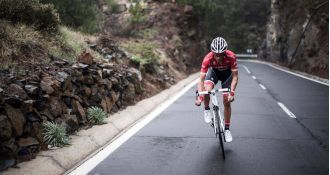

With summer now in full swing, there's no better time to head off on a long ride and make the most of the surprisingly pleasant weather. No matter where you are, it's tough to avoid some sort of climb on those longer days in the saddle, and nobody wants to be lagging at the back of the group when the gradient gets tricky. With that in mind, here are a few pointers that will help you eat up the vertical metres with relative ease.
Nutrition
Every cyclist's least favourite of the laws of physics, it is regrettable that the more something weighs, the harder it must be pushed to go uphill. Whilst gravity remains an obstacle, the best thing to do is to lose some weight, and that starts with your diet. There's a host of nutritional advice out there, so you're sure to find something that works for you. From a cycling perspective, though, it's important not to starve yourself. Losing 10 kilos is no good if you're running on empty for the duration of your ride. It's important to strike a balance; a low-fat diet that allows for some carbohydrate to fuel your training rides.
Training
Of course, the other option is to work on your power. Not everybody has an Alpe d'Huez in their back garden to do hill repeats on, but that's no excuse for not getting your climbing legs into shape. High intensity interval training (HIIT) on flat roads or the indoor trainer are a great substitute for conquering the local 'col'. Try and simulate the kind of sustained threshold efforts that climbing entails. 3x6min or 3x8min efforts with a decent rest in between repetitions will build leg strength and boost the power side of that all-important power to weight ratio. A turbo trainer is a hugely valuable piece of kit for the enthusiastic cyclist pressed for time or with winter training in mind. Here are a few of the options available:
Equipment
There's no doubt that shedding kilos and putting in hard hours in the saddle is the tried and tested route to faster climbing. However, for those who seek a more immediate shortcut to success, why not shed weight from your bike instead? If you've watched any racing this year, you'll have seen the likes of Alberto Contador and his Trek-Segafredo teammates make light work of many a mountain, and that's in no small part thanks to the Emonda. The lightest frame in Trek's substantial arsenal, it certainly fits the bill here. See for yourself:
{:A1827}
Alternatively, if you're happy with your current frame, you could invest in a set of light climbing wheels. Rather than battling uphill on a set of heavy deep-section wheels, opting for a shallower rim, or even a carbon one, will make those uphill efforts that little bit less soul-destroying. Fulcrum's Racing line of wheels are trusted by pros and amateurs alike, and their top-of-the-range Zero wheel is available with carbon rims and aluminium spokes. The result? An elite, lightweight climbing wheel with an unmatched stiffness.
Follow any of these tips and before long, you'll be unleashing hurt on your riding partners every time the road kicks uphill.